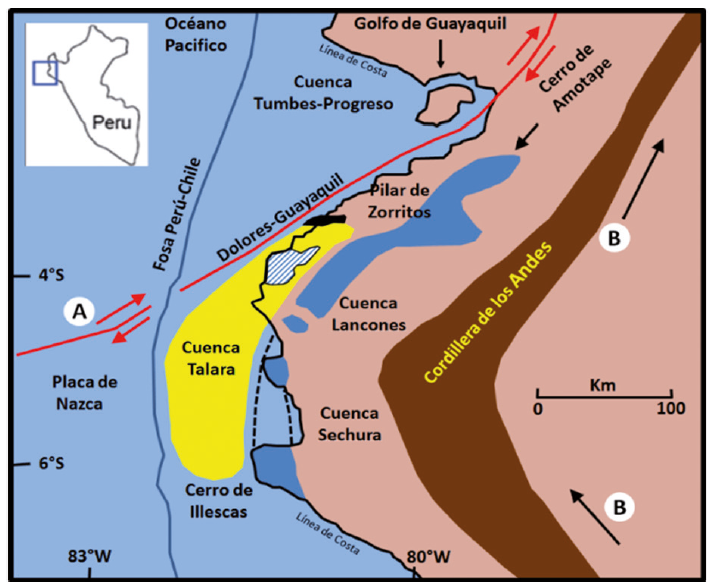Probabilistic study of advanced methods in decline curve analysis (DCA) used for the estimation of oil reserves during the transient flow regime.

Published 2020-03-11
Keywords
- Decline curve analysis,
- DCA,
- Low permeability reservoirs,
- Tight conventional reservoirs,
- Oil forecasts
- Monte Carlo Simulation,
- Transient flow,
- Type curve ...More
How to Cite
Abstract
The reservoirs of the Peruvian Northwest have produced, for more than a century, mainly low permeability silicoclastic sandstones through deposits in compartments or sub-blocks generated by high faulting. The characteristic depletion drive mechanism is solution gas and the wells are commonly built with an artificial lift system by mechanical pumping or gas lift; the average recovery factor reached in these deposits is between 8% and 15%.
In recent years, a great advance has been observed in reserve estimation techniques through the analysis of decline curves (DCA) in unconventional deposits with very low permeability. These techniques can also be used in tight conventional reservoirs, those typically found in the Talara Basin in Peru, in which the application of the traditional DCA technique often overestimates production forecasts and reserve calculations. Alternatively, it has been proposed to evaluate the Stretched Exponential Decline Model (SEDM), Power Law, Duong and Extended Exponential Decline, in the reservoirs of this basin.
During the evaluation process, information from 30 producing wells from different tight reservoirs in the Talara Basin was used: Manta, Mesa, Mogollón and Pariñas Inferior. The aforementioned decline analysis methods were tested with the production history of the first 6, 12 and 24 months; It should be mentioned that, according to the observation made and due to the low productivity of these reservoirs, it was determined that their flow was still in a transitory state during the analysis period. The forecasts were compared with actual production data and the decline models were ranked in order of priority according to the certainty of their degree of adjustment. The most suitable technique was chosen to generate, through a probabilistic approach and using Monte Carlo simulation, a set of type curves for the Talara basin; thus, the P90, P50 and P10 percentiles were obtained.
The permeability ranges in the reservoirs in the evaluated cases fluctuate between 0.01 and 1 mD. It has been observed that the application of ARPs’ traditional DCA model in wells with little production history of low permeability reservoirs, proves to be inefficient in the reserve calculation forecasts. furthermore, the new DCA methods are more conservative in their forecasts and, therefore, more accurate in this case because they allow the incorporation of transient information. The application of this new approach will help to obtain reliable forecasts in the evaluation of future development strategies and to predict with greater certainty the production of future workover jobs and new development wells.
Downloads
References
Duong, A. N. (2010, January). An unconventional rate decline approach for tight and fracture-dominated gas wells. In Canadian unconventional resources and international petroleum conference. Society of Petroleum Engineers.
Fetkovich, M. J., Fetkovich, E. J., & Fetkovich, M. D. (1996). Useful concepts for decline curve
orecasting, reserve estimation, and analysis. SPE Reservoir Engineering, 11(01), 13-22.
Guardia, V. M. D., Torres, M. C., Arenas, C. E. V., Castro, R. H., Toro, G. M., & Mendoza, O. B. (2011). Análisis de riesgo y simulación de monte carlo en la valoración de proyectos–aplicación en la industria de los hidrocarburos. Fuentes, el reventón energético, 9(2).
Ilk, D., Rushing, J. A., Perego, A. D., & Blasingame, T. A. (2008, January). Exponential vs. hyperbolic decline in tight gas sands: understanding the origin and implications for reserve estimates using Arps’ decline curves. In SPE annual technical conference and exhibition. Society of Petroleum Engineers.
Páez, E. G. M., González, F. E. C., & Duarte, C. A. M. (2016). Aplicación de series de tiempo en la realización de pronósticos de producción. Fuentes: El reventón energético, 14(1), 79-88.
Valko, P. P. (2009, January). Assigning value to stimulation in the Barnett Shale: a simultaneous analysis of 7000 plus production hystories and well completion records. In SPE hydraulic fracturing technology conference. Society of Petroleum Engineers.
Zhang, H. E., Cocco, M., Rietz, D., Cagle, A., & Lee, J. (2015, October). An empirical extended exponential decline curve for shale reservoirs. In SPE Annual Technical Conference and Exhibition. Society of Petroleum Engineers.